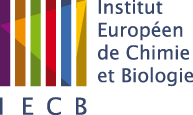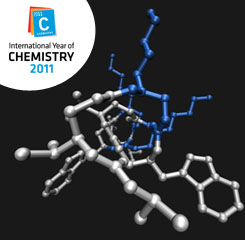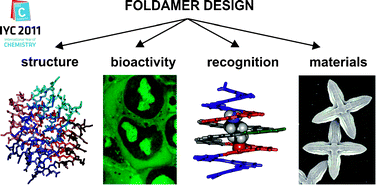| A review on synthetic foldamers in ChemComm to celebrate the International Year of Chemistry 2011 |
|
A review on synthetic foldamers in ChemComm to celebrate the International Year of Chemistry 2011 Ivan Huc and Gilles Guichard are both interested in the chemistry of foldamers: artificial molecules that mimic the ability of proteins, nucleic acids, and polysaccharides to fold into well-defined conformations. In the context of the International Year Chemistry 2011, they were invited to highlight recent advances in foldamer chemistry in Chemical Communications.
Current developments suggest that foldamer chemistry could be applied to a wide variety of fields. In pharmacology, foldamers represent innovative tools to interfere with biological functions. Research has shown their relevance for the development of new antiviral agents (against HIV for instance) and to reach intracellular targets involved in human cancer. But foldamers also opens new avenues which go beyond the reach of biopolymers. The surface of foldamers as well as the cavity of their folded structure can be used for molecular recognition. One recent advance in this domain was achieved by the team of Ivan Huc at IECB, with the design of the first self-assembled molecular engine: helices that wrap around rod-like guests and can slide along them much faster than they dissociate. Another promising prospect of foldamer chemistry lies in the creation of materials with morphological features at the nano-or-microscale, such as surfaces with photoelectronic properties. Gilles Guichard & Ivan Huc (2011) Synthetic foldamers,Chem. Commun., 2011, 47, 5933-5941 |
2, Rue Robert Escarpit - 33607 PESSAC - France
Tel. : +33 (5) 40 00 30 38 - Fax. : +33 (5) 40 00 30 68






